Key takeaways:
- The UK news media landscape is evolving, with a significant shift from traditional print to digital platforms, impacting reading habits and audience engagement.
- Challenges such as declining advertising revenue, competition from tech giants, and the rise of misinformation threaten the sustainability and trustworthiness of news sources.
- Personalization and multimedia storytelling are emerging trends in news consumption, potentially leading to more individualized echo chambers rather than diverse perspectives.
- Engaging with diverse viewpoints and participating in news literacy exercises are essential for fostering informed citizenry and understanding the implications of news on local communities.
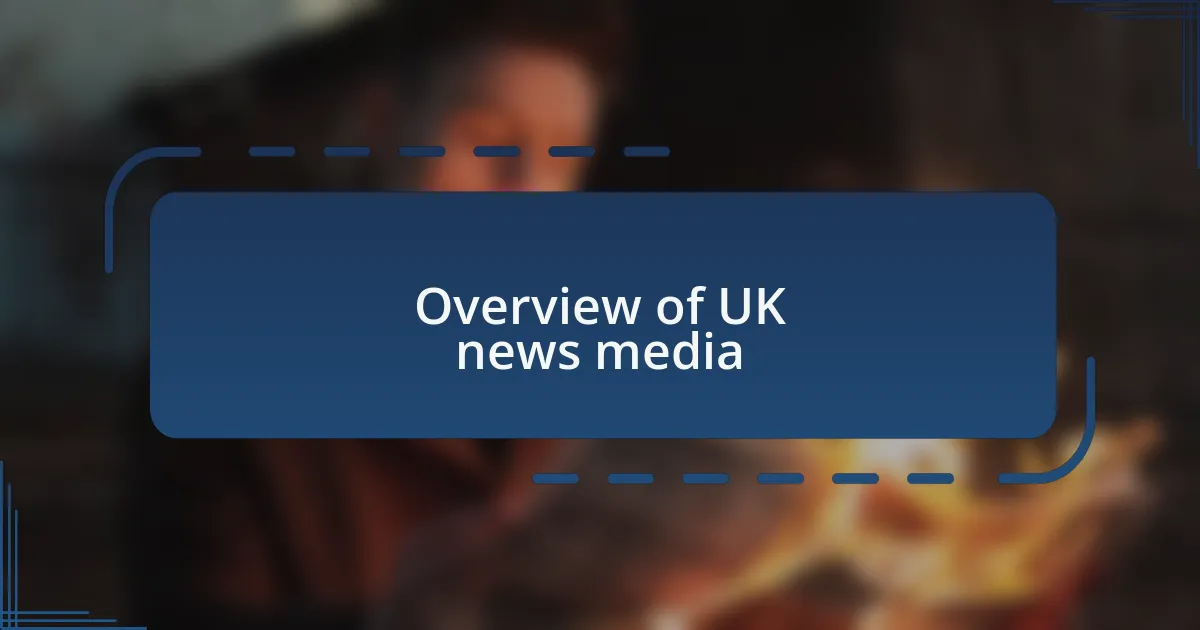
Overview of UK news media
The UK news media landscape is diverse, consisting of an array of platforms from traditional newspapers like The Times and The Guardian to digital-native entities like Vice and BuzzFeed. I often reflect on how this mixture of established and modern outlets creates a vibrant, albeit complex, environment for news consumption. Isn’t it fascinating how each platform has its distinct style, appealing to different audiences?
When I think back to my early days as a news consumer, flipping through the pages of my local paper each morning, I realize how much has changed. The rise of online news has transformed how we access information, shifting the focus from print to screens. Have you noticed how this change has also altered our reading habits? We now crave instant updates and bite-sized content, yet this can sometimes come at the cost of depth and context.
As we navigate this evolving landscape, it’s essential to consider how trust plays a pivotal role. Many people, including myself, grapple with distinguishing credible sources from sensational ones in an age where misinformation spreads rapidly. What makes a news outlet trustworthy? I’ve found that transparency and accountability are critical indicators, yet even then, I still feel a tug of skepticism now and then.
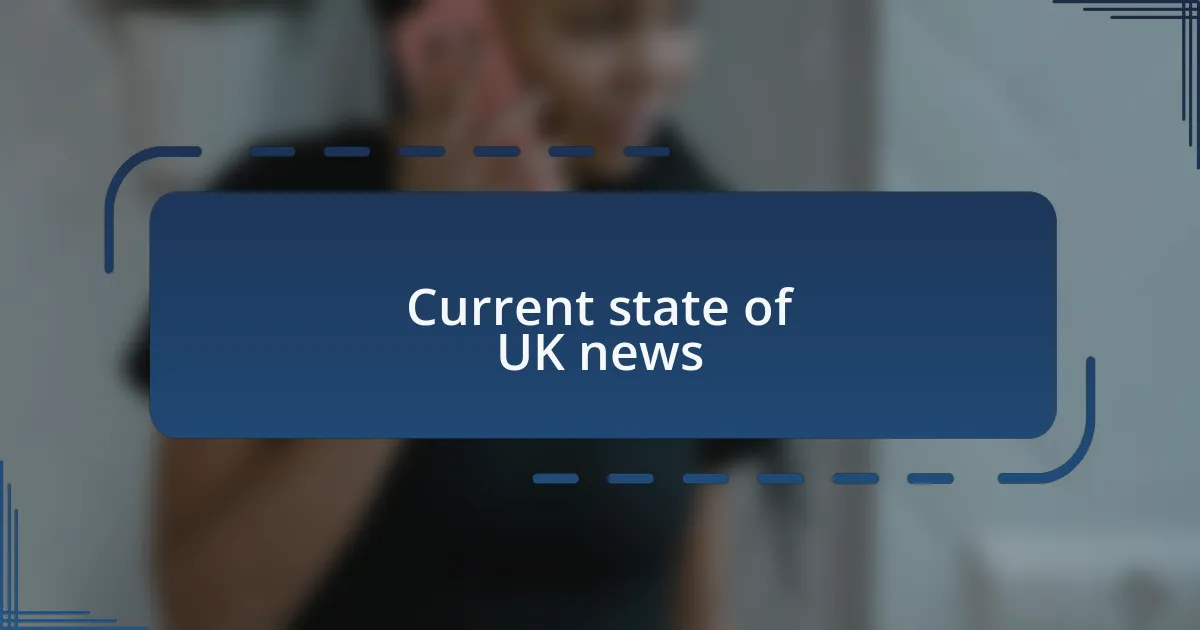
Current state of UK news
The current state of UK news is marked by a strong shift towards digital consumption, with statistics revealing that more people now obtain their news online than ever before. I remember the first time I discovered news apps on my phone; it felt like having a newsstand in my pocket, but I also felt this unsettling pressure to stay constantly updated. How does that really affect our ability to engage with news more thoughtfully?
Mainstream media has also seen considerable challenges in audience trust and engagement, which has resulted in significant layoffs and budget cuts in many well-known publications. It’s hard not to feel a sense of loss when institutions that once stood as beacons of reliable journalism struggle to survive. Have you ever questioned which voices are being silenced in this economic crunch?
Moreover, the rise of social media platforms as primary news sources warrants scrutiny, as they often amplify sensationalism over substance. When I scroll through my feed, I sometimes feel overwhelmed by the sheer volume of information, much of it lacking the depth I crave. This makes me wonder: are we sacrificing richer narratives for the sake of quick clicks and shares?
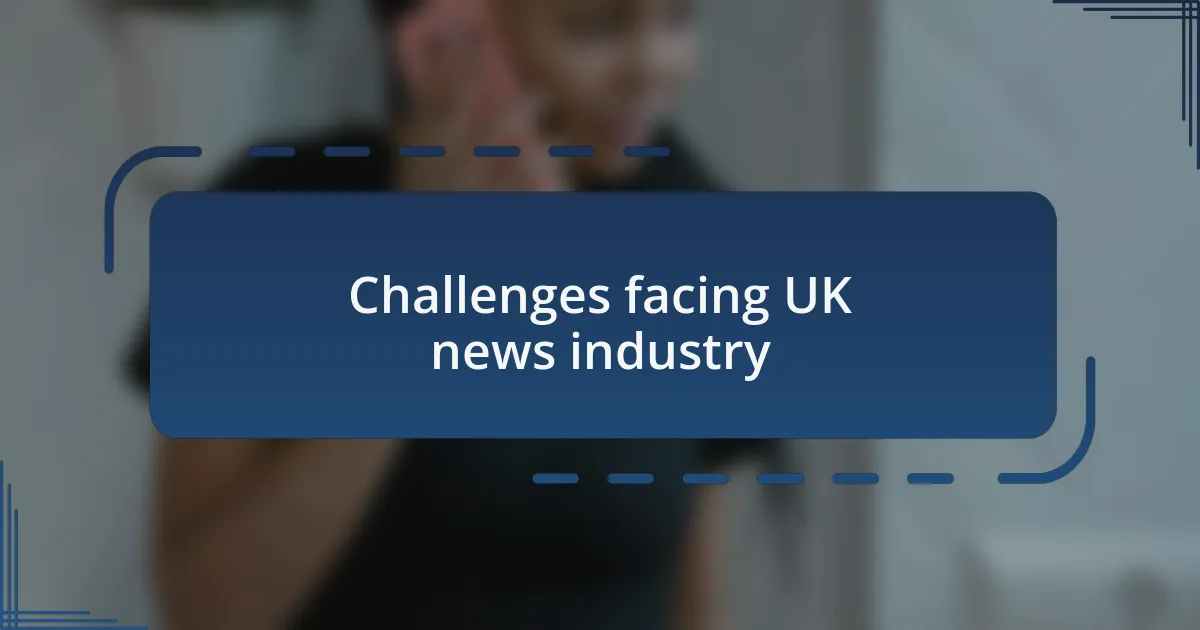
Challenges facing UK news industry
The UK news industry faces significant financial struggles, largely attributed to declining advertising revenue. I remember when local papers in my area had vibrant community sections; they thrived on ads from local businesses. Now, it’s disheartening to see many fold or reduce their output, leaving a void in local journalism. How many unique local stories are we missing out on because the funding just isn’t there?
Another challenge lies in the competition with tech giants like Facebook and Google, which dominate online advertising. I often find myself frustrated when I see my newsfeed filled with clickbait headlines from lesser-known sites, overshadowing the reputable voices that provide context and depth. This begs the question: are we allowing algorithms to dictate the quality of news we consume?
Moreover, the rise of misinformation poses a tremendous threat to public discourse. It’s alarming how easily false narratives spread, as I’ve encountered friends who share sensational stories without checking their sources. In a time when trust in media is already fragile, how can we foster a culture of critical thinking and media literacy among readers?
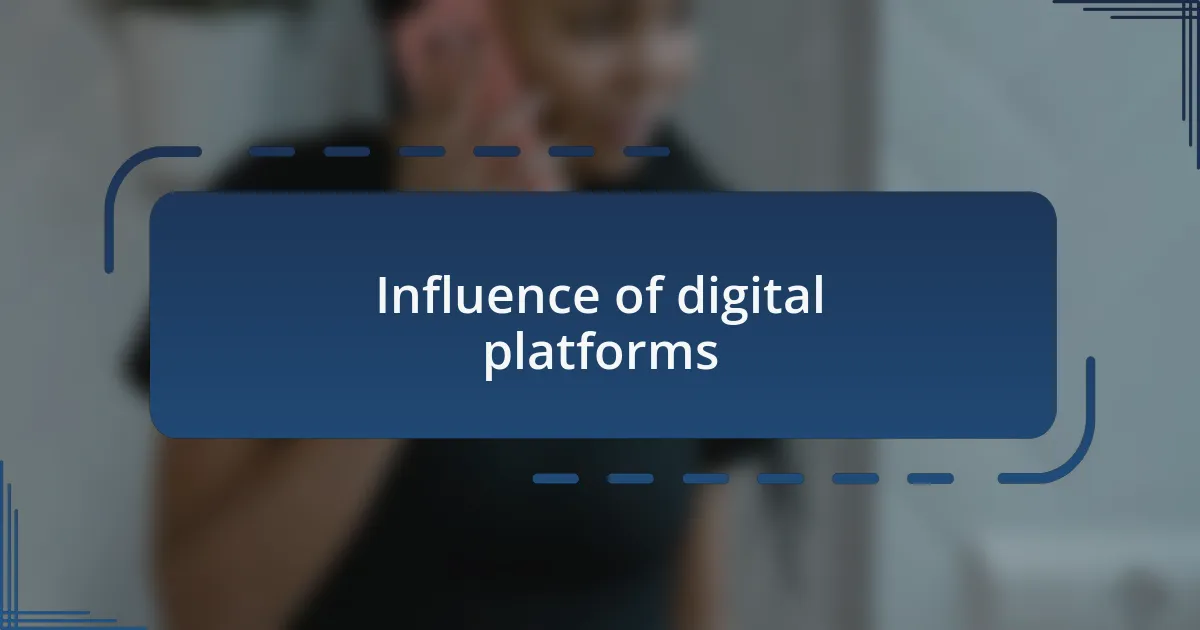
Influence of digital platforms
Digital platforms have transformed how we access news, placing immense power in the hands of social media algorithms. I often find myself scrolling through my feeds, where trending stories pop up based on engagement rather than reliability. It makes me wonder: is this really the best way to curate the news I consume?
The immediacy of digital platforms also means that news now travels at lightning speed. I recall a time when breaking news took a moment to digest; now, I receive alerts within seconds, leaving little space for reflection. While this can foster a sense of urgency, it sometimes prioritizes speed over accuracy—how many stories have we seen retracted or corrected just hours after they broke?
Furthermore, the rise of subscription-based models on platforms like Substack highlights a shift in how stories are valued. I’ve become invested in a few writers whose perspectives resonate with me, which emphasizes the importance of niche journalism. But I can’t help but ask: are we moving away from communal news consumption towards individualized echo chambers? This transition could redefine our collective understanding of important issues in society.
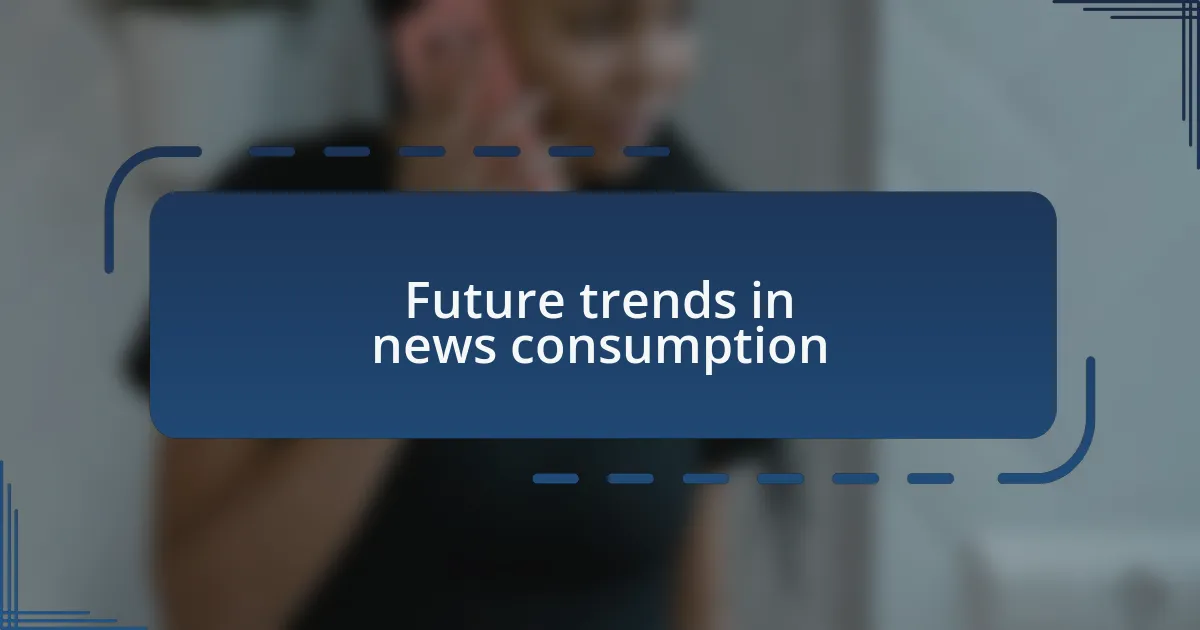
Future trends in news consumption
As I look ahead, it’s evident that personalization will become a key trend in news consumption. Platforms are increasingly leveraging data to tailor content to our interests. I often notice how articles pop up that align closely with topics I’ve previously engaged with, making me wonder—are we losing the diversity of perspectives that a more random selection of news once offered?
Another noteworthy trend is the growing significance of multimedia storytelling. I find that I’m drawn to news formats that incorporate video, podcasts, or interactive elements. For instance, I recently watched a documentary-style report that was far more engaging than traditional articles. It made me think: could this shift towards richer media experiences change my deeper understanding of complex issues?
Finally, there’s an intriguing move towards community-driven journalism. In my neighborhood, local initiatives are starting to emerge, where residents contribute to reporting on community affairs. This participation not only fosters a sense of ownership but also raises the question—will these grassroots efforts outweigh conventional media sources in trust and relevance? It’s a development I keenly observe, as it might reshape the very fabric of how we engage with news.
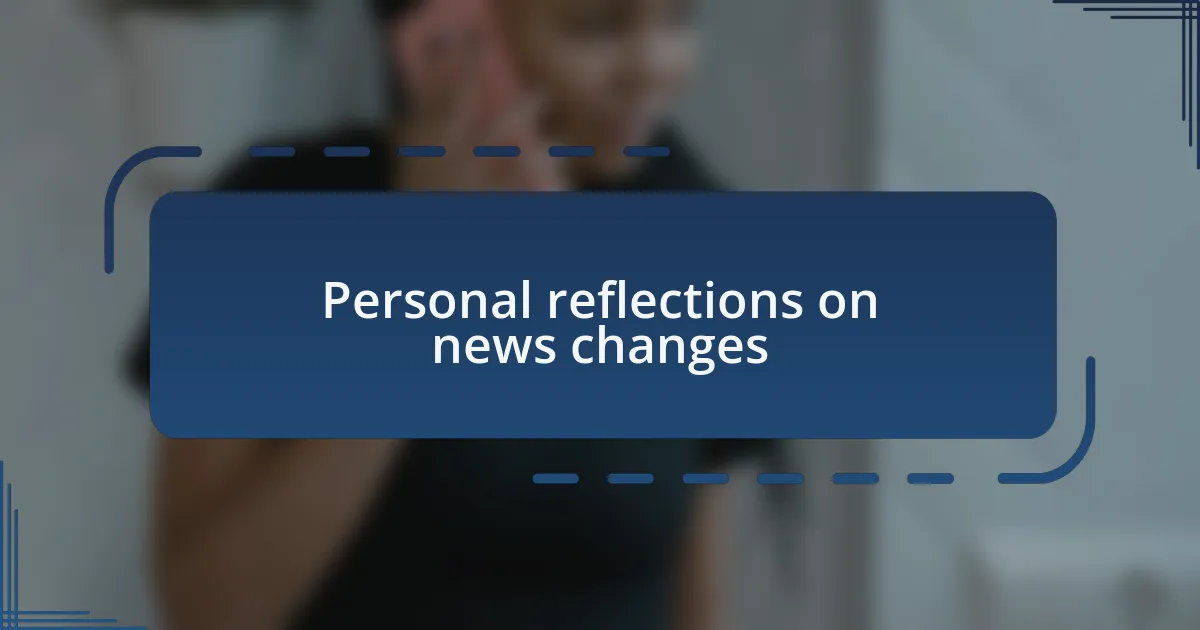
Personal reflections on news changes
As I reflect on the evolution of news in recent years, it strikes me how rapidly the landscape has shifted. I remember the excitement of flipping through the morning paper, absorbing headlines without the influence of algorithms. Now, it feels like my feed often prioritizes stories that confirm my existing views, which leads me to ponder—am I truly informed, or merely entertained?
I’ve also noticed how my relationship with news has become more emotional. I often engage more deeply with stories that elicit a reaction, especially when they feature real people and their struggles. Just the other day, I came across a heartfelt article about mental health that resonated with my own experiences. This raises a question for me: will this emotional connection to storytelling become the new standard for how we consume news?
I can’t help but feel nostalgic for the days of straightforward reporting, where the focus was on delivering facts rather than fostering engagement metrics. It makes me wonder if the relentless drive for clicks is nudging more traditional forms of journalism to the background. What does that mean for the quality of information we receive? It’s a conversation worth having as we all navigate these changes together.
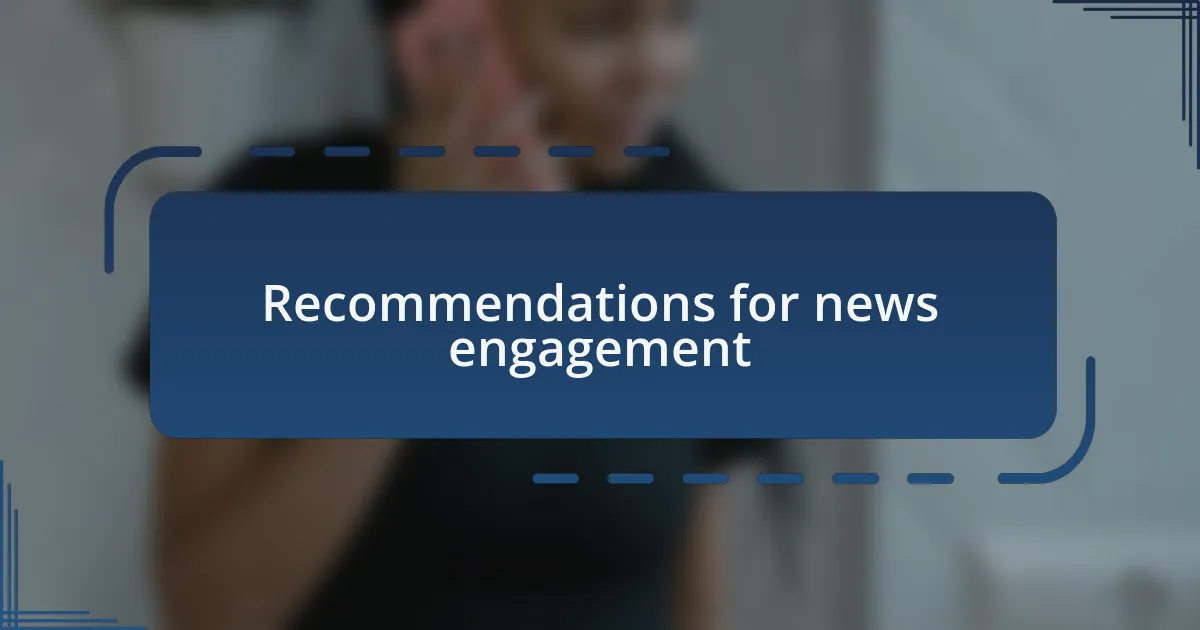
Recommendations for news engagement
It’s essential to cultivate a habit of seeking diverse perspectives when engaging with the news. When I scroll through various outlets—some I agree with and others I don’t—I find myself challenging my viewpoints. It makes me wonder, how many of us actively make an effort to understand the other side of the story? Expanding my sources has not only enriched my understanding but often leads to more nuanced discussions with friends and family.
Another recommendation is to engage in news literacy exercises. I remember participating in a workshop that dissected how to critically assess news stories, especially with the prevalence of misinformation. Has anyone else tried something similar? This experience opened my eyes to the techniques used in sensationalizing headlines, helping me navigate through the clutter of information much more effectively.
Finally, I urge everyone to prioritize experiences that connect news to real-life implications. Recently, after attending a community event centered around climate change, I was inspired to follow local news more actively. Engaging with news in ways that feel personally relevant drives home the impact of reporting and motivates me to stay informed. How might your local community be shaping the stories you don’t always see in the headlines? Exploring this could transform how one relates to current events.